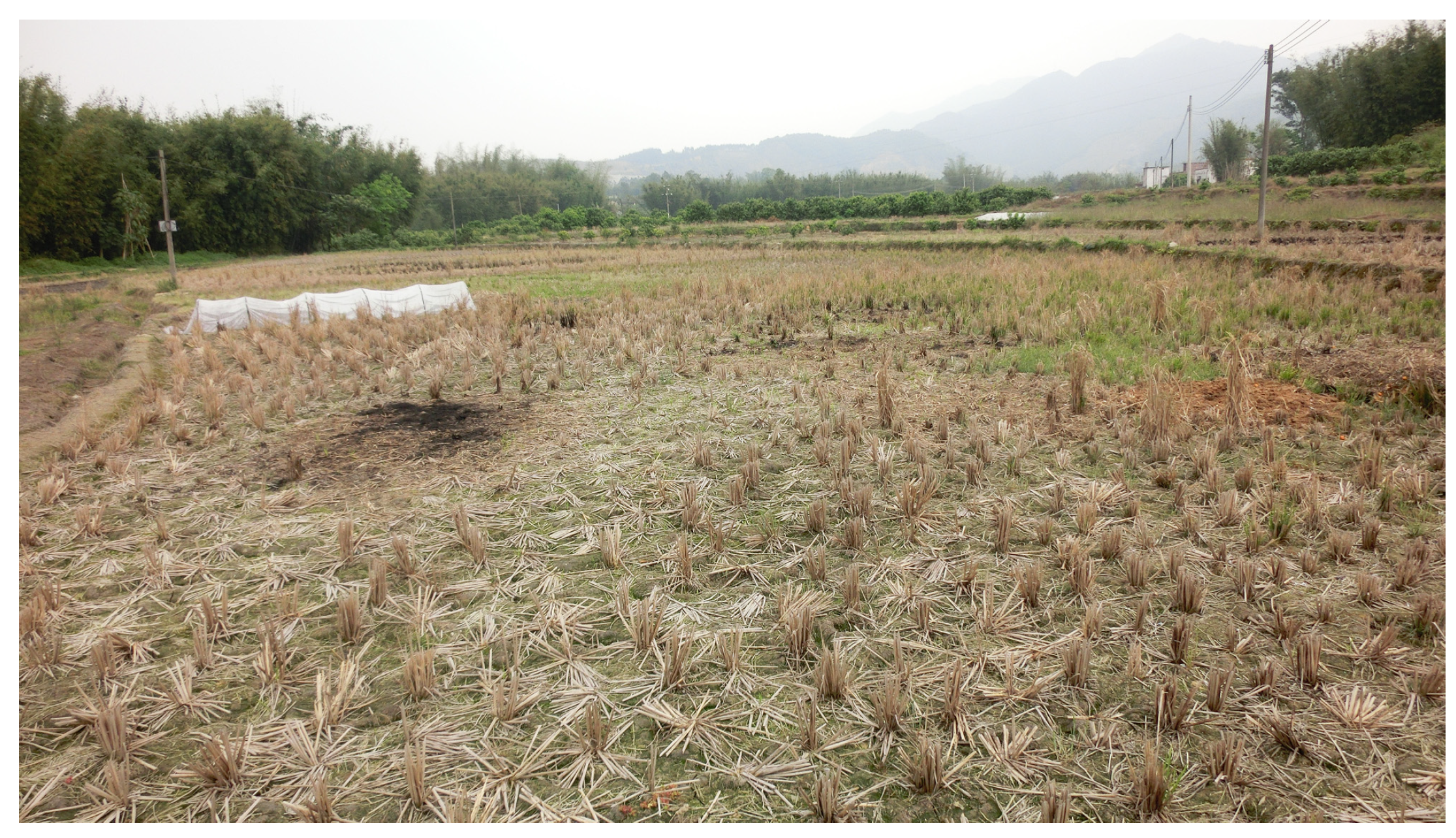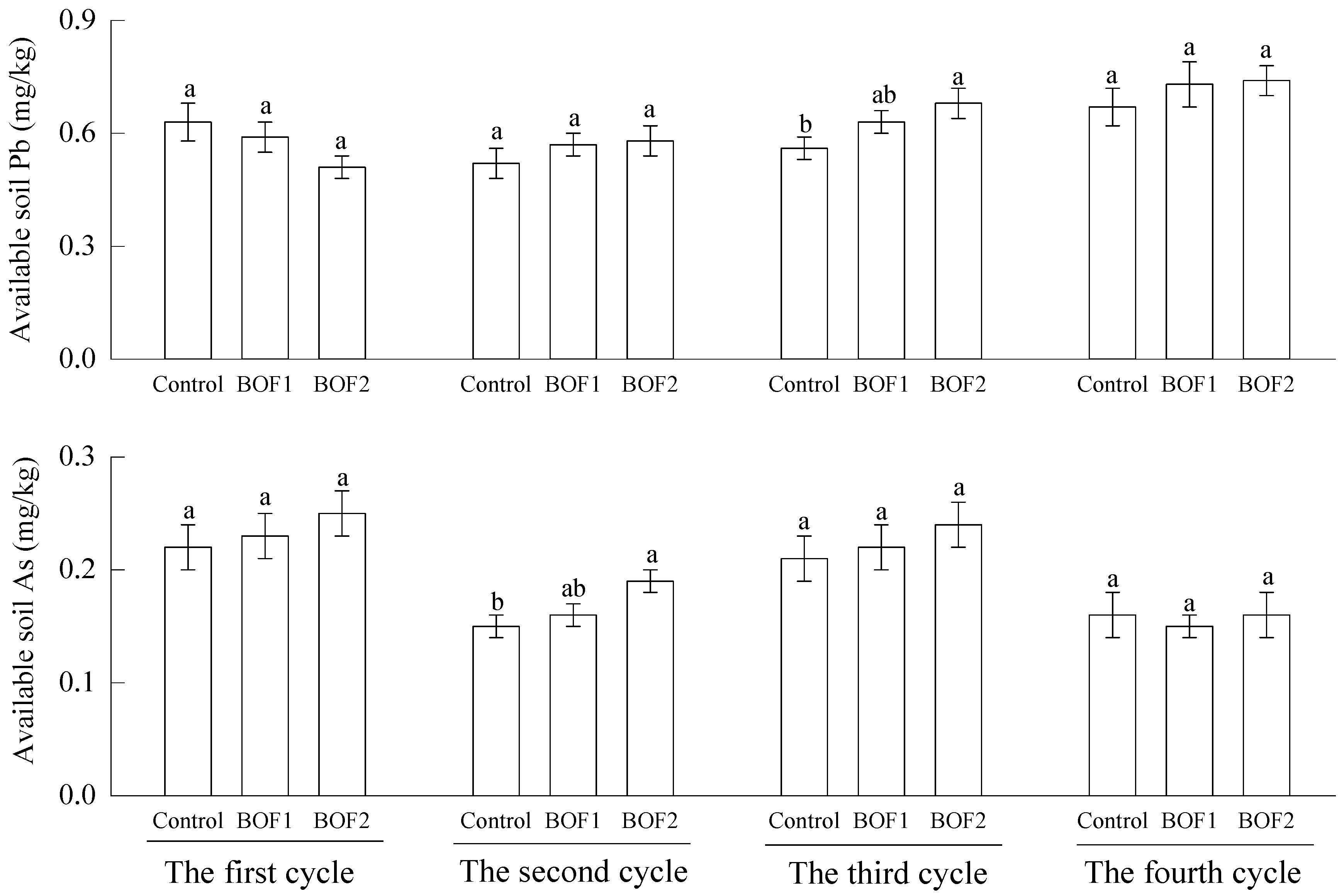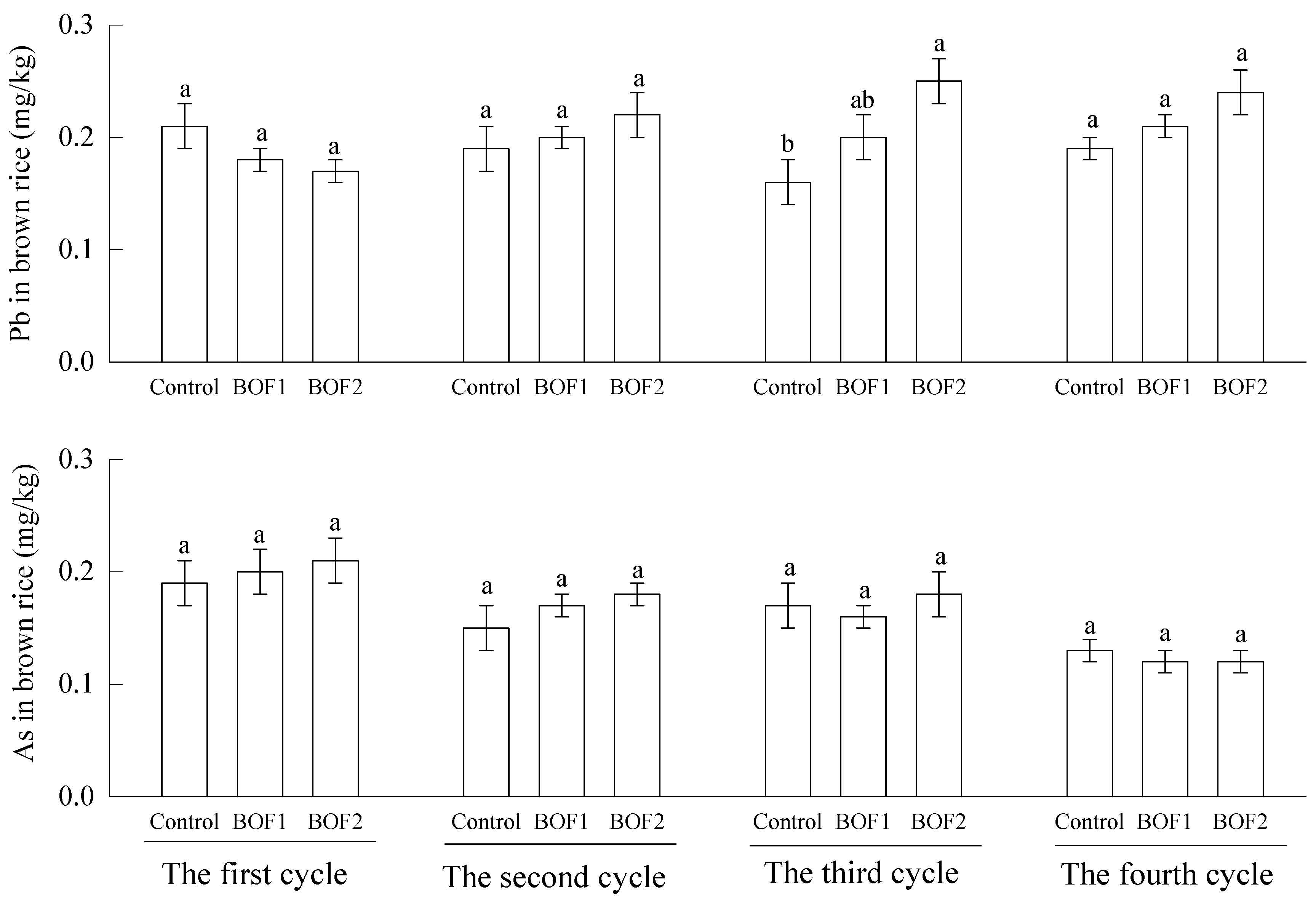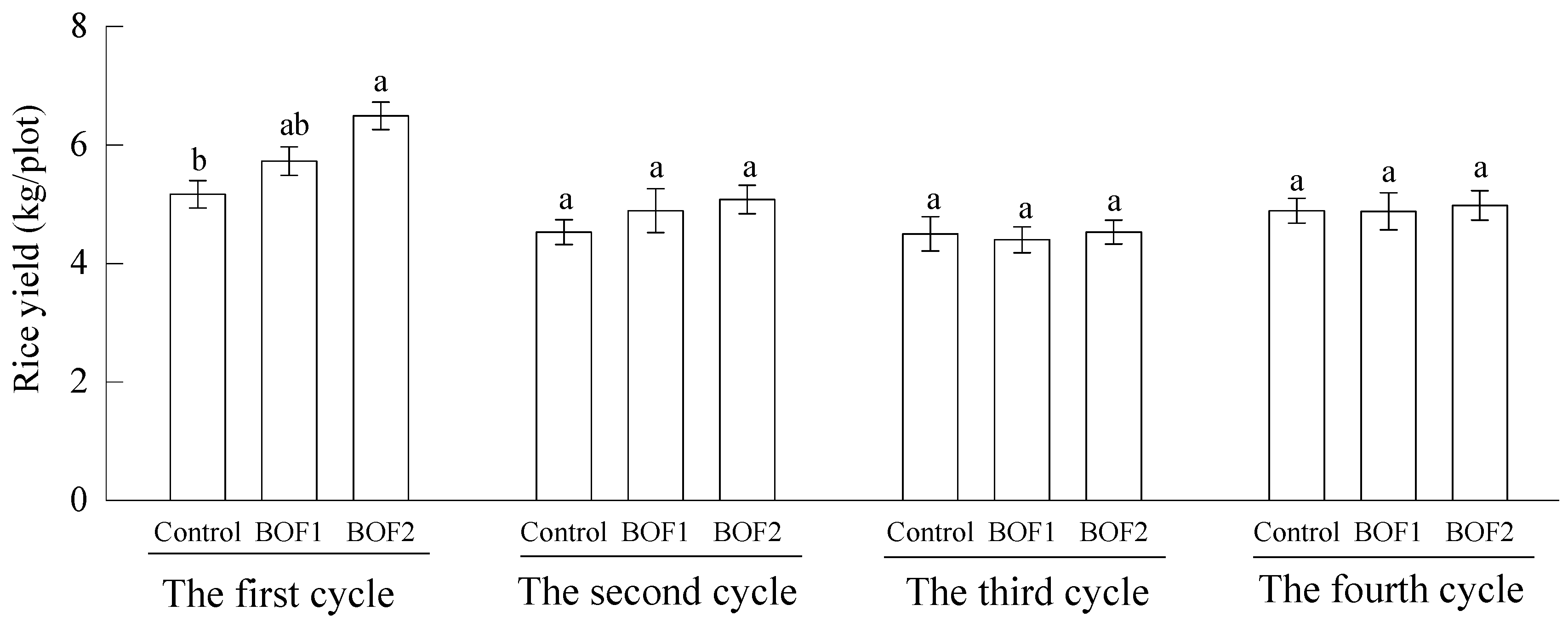A Two-Year Study of Bioorganic Fertilizer on the Content of Pb and As in Brown Rice and Rice Yield in a Contaminated Paddy Field
Abstract
:1. Introduction
2. Materials and Methods
2.1. Experimental Site, Bioorganic Fertilizer, and Rice Variety
2.2. Field Experiment Design
2.3. Sampling and Analytical Methods
2.4. Statistical Analysis
3. Results
3.1. BOF Effects on Available Pb and As in Soil
3.2. BOF Effects on pH, TOC, FDA Hydrolase Activity, and Bulk Density in Soil
3.3. BOF Effects on Pb and As Concentrations in Brown Rice
3.4. BOF Effects on Rice Yield
4. Discussion
5. Conclusions
Author Contributions
Funding
Institutional Review Board Statement
Data Availability Statement
Conflicts of Interest
References
- Jing, F.; Chen, X.M.; Yang, Z.J.; Guo, B.L. Heavy metals status, transport mechanisms, sources, and factors affecting their mobility in Chinese agricultural soils. Environ. Earth Sci. 2018, 77, 104. [Google Scholar] [CrossRef]
- Khanam, R.; Kumar, A.; Nayak, A.K.; Shahid, M.; Tripathi, R.; Vijayakumar, S.; Bhaduri, D.; Kumar, U.; Mohanty, S.; Panneerselvam, P.; et al. Metal(loid)s (As, Hg, Se, Pb and Cd) in paddy soil: Bioavailability and potential risk to human health. Sci. Total Environ. 2020, 699, 134330. [Google Scholar] [CrossRef] [PubMed]
- Raj, D.; Maiti, S.K. Sources, bioaccumulation, health risks and remediation of potentially toxic metal(loid)s (As, Cd, Cr, Pb and Hg): An epitomised review. Environ. Monit. Assess. 2020, 192, 108. [Google Scholar] [CrossRef] [PubMed]
- Gao, P.; Huang, J.; Wang, Y.; Li, L.J.; Sun, Y.Y.; Zhang, T.; Peng, F.Y. Effects of nearly four decades of long-term fertilization on the availability, fraction and environmental risk of cadmium and arsenic in red soils. J. Environ. Manag. 2021, 295, 113097. [Google Scholar] [CrossRef] [PubMed]
- Kumpiene, J.; Antelo, J.; Brännvall, E.; Carabante, I.; Ek, K.; Komarek, M.; Söderberg, C.; Wårell, L. In situ chemical stabilization of trace element-contaminated soil–Field demonstrations and barriers to transition from laboratory to the field—A review. Appl. Geochem. 2019, 100, 335–351. [Google Scholar] [CrossRef]
- Ye, L.; Zhao, X.; Bao, E.C.; Li, J.S.; Zou, Z.R.; Cao, K. Bio-organic fertilizer with reduced rates of chemical fertilization improves soil fertility and enhances tomato yield and quality. Sci. Rep. 2020, 10, 177. [Google Scholar] [CrossRef]
- Ye, C.M.; Huang, S.F.; Sha, C.Y.; Wu, J.Q.; Cui, C.Z.; Su, J.H.; Ruan, J.J.; Tan, J.; Tang, H.; Xue, J.J. Changes of bacterial community in arable soil after short-term application of fresh manures and organic fertilizer. Environ. Technol. 2022, 43, 824–834. [Google Scholar] [CrossRef]
- Bolan, N.; Kunhikrishnan, A.; Thangarajan, R.; Kumpiene, J.; Park, J.; Makino, T.; Scheckel, K. Remediation of heavy metal(loid)s contaminated soils—To mobilize or to immobilize? J. Hazard. Mater. 2014, 266, 141–166. [Google Scholar] [CrossRef] [PubMed]
- Pramanick, B.; Mahapatra, B.S.; Datta, D.; Dey, P.; Singh, S.P.; Kumar, A.; Paramanik, B.; Awasthi, N. An innovative approach to improve oil production and quality of mustard (Brassica juncea L.) with multi-nutrient-rich polyhalite. Heliyon 2023, 9, e13997. [Google Scholar] [CrossRef]
- Muhammad, Q.; Liu, Y.R.; Huang, J.; Liu, K.; Muhammad, M.; Lv, Z.Z.; Hou, H.Q.; Lan, X.J.; Ji, J.H.; Waqas, A.; et al. Soil nutrients and heavy metal availability under long-term combined application of swine manure and synthetic fertilizers in acidic paddy soil. J. Soil Sediments 2020, 20, 2093–2106. [Google Scholar]
- Chen, C.; Lv, Q.; Tang, Q. Impact of bio-organic fertilizer and reduced chemical fertilizer application on physical and hydraulic properties of cucumber continuous cropping soil. Biomass Convers. Biorefinery 2022, 14, 921–930. [Google Scholar] [CrossRef]
- Kumar, S.; Bauddh, K.; Barman, S.; Singh, R.P. Amendments of microbial bio-fertilizers and organic substances reduces requirement of urea and DAP with enhanced nutrient availability and productivity of wheat (Tritium aestivum L.). Ecol. Eng. 2014, 71, 432–437. [Google Scholar] [CrossRef]
- Lu, H.J.; Zhou, D.L.; Ye, W.L.; Fan, T.; Ma, Y.H. Advances in application of bio-organic fertilizer in soil improvement and remediation of heavy metals pollution. Environ. Pollut. Control 2019, 41, 1378–1383. (In Chinese) [Google Scholar]
- Li, Z.R.; Luo, S.Q.; Peng, Y.J.; Jin, C.Z.; Liu, D.C. Effect of long-term application of bioorganic fertilizer on the soil property and bacteria in rice paddy. AMB Express 2023, 13, 60. [Google Scholar] [CrossRef] [PubMed]
- Qiu, M.H.; Zhang, R.F.; Xue, C.; Zhang, S.S.; Li, S.Q.; Zhang, N.; Shen, Q.R. Application of bio-organic fertilizer can control Fusarium wilt of cucumber plants by regulating microbial community of rhizosphere soil. Biol. Fertil. Soils 2012, 48, 807–816. [Google Scholar] [CrossRef]
- Wu, Y.; Zhao, C.Y.; Farmer, J.; Sun, J. Effects of bio-organic fertilizer on pepper growth and Fusarium wilt biocontrol. Sci. Hortic. 2015, 193, 14–120. [Google Scholar] [CrossRef]
- Ansari, R.A.; Mahmood, I. Optimization of organic and bio-organic fertilizers on soil properties and growth of pigeon pea. Sci. Hortic. 2017, 226, 1–9. [Google Scholar] [CrossRef]
- Wang, L.; Li, J.; Yang, F.; E, Y.; Raza, W.; Huang, Q.W.; Shen, Q.R. Application of bioorganic fertilizer significantly increased apple yields and shaped bacterial community structure in orchard soil. Microb. Ecol. 2017, 73, 404–416. [Google Scholar] [CrossRef] [PubMed]
- Feng, N.X.; Liang, Q.F.; Feng, Y.X.; Xiang, L.; Zhao, H.M.; Li, Y.W.; Li, H.; Cai, Q.Y.; Mo, C.H.; Wong, M.H. Improving yield and quality of vegetable grown in PAEs-contaminated soils by using novel bioorganic fertilizer. Sci. Total Environ. 2020, 739, 139883. [Google Scholar] [CrossRef]
- He, H.D.; Tam, N.Y.N.; Qiu, R.L.; Yao, A.J.; Ye, Z.H. Effects of alkaline and bioorganic amendments on cadmium, lead, zinc, and nutrient accumulation in brown rice and grain yield in acidic paddy fields contaminated with a mixture of heavy metals. Environ. Sci. Pollut. Res. 2016, 23, 23551–23560. [Google Scholar] [CrossRef]
- Kong, F.Y.; Lu, S.G. Effects of microbial organic fertilizer (MOF) application on cadmium uptake of rice in acidic paddy soil: Regulation of the iron oxides driven by the soil microorganisms. Environ. Pollut. 2022, 307, 119447. [Google Scholar] [CrossRef]
- Zeng, F.; Ali, S.; Zhang, H.T.; Ouyang, Y.N.; Qiu, B.Y.; Wu, F.B.; Zhang, G.P. The influence of pH and organic matter content in paddy soil on heavy metal availability and their uptake by rice plants. Environ. Pollut. 2011, 159, 84–91. [Google Scholar] [CrossRef]
- Wang, K.R.; Zhang, Y.Z.; Hu, R.G. Effects of different types of soil amelioration materials on reducing concentrations of Pb and Cd in brown rice in heavy metal polluted paddy soils. J. Agro-Environ. Sci. 2007, 26, 476–481. (In Chinese) [Google Scholar]
- Zheng, R.L.; Chen, Z.; Cai, C.; Tie, B.Q.; Liu, X.L.; Reid, B.J.; Huang, Q.; Lei, M.; Sun, G.X.; Baltrėnaitė, E. Mitigating heavy metal accumulation into rice (Oryza sativa L.) using biochar amendment—A field experiment in Hunan, China. Environ. Sci. Pollut. Res. 2015, 22, 11097–11108. [Google Scholar] [CrossRef] [PubMed]
- Park, J.H.; Lamb, D.; Paneerselvam, P.; Choppala, G.; Bolan, N.; Chung, J.W. Role of organic amendments on enhanced bioremediation of heavy metal(loid) contaminated soils. J. Hazard. Mater. 2011, 185, 549–574. [Google Scholar] [CrossRef]
- Lu, C.Y.; Zhang, Z.C.; Guo, P.R.; Wang, R.; Liu, T.; Luo, J.Q.; Hao, B.H.; Wang, Y.C.; Guo, W. Synergistic mechanisms of bioorganic fertilizer and AMF driving rhizosphere bacterial community to improve phytoremediation efficiency of multiple HMs-contaminated saline soil. Sci. Total Environ. 2023, 883, 163708. [Google Scholar] [CrossRef] [PubMed]
- Gong, Y.Y.; Zhao, D.Z.; Wang, Q.L. An overview of field-scale studies on remediation of soil contaminated with heavy metals and metalloids: Technical progress over the last decade. Water Res. 2018, 147, 440–460. [Google Scholar] [CrossRef]
- He, H.D.; Xiao, Q.Q.; Yuan, M.; Huang, R.; Sun, X.B.; Wang, X.M.; Zhao, H.Q. Effects of steel slag amendments on accumulation of cadmium and arsenic by rice (Oryza sativa) in a historically contaminated paddy field. Environ. Sci. Pollut. Res. 2020, 27, 40001–40008. [Google Scholar] [CrossRef]
- Liu, H.F.; Ma, J.H.; Jing, L.; Lu, Q.; Yan, W.D.; Wang, X.C. Determination of activity of FDA hydrolysis in paddy soils and its application in Taihu lake region. Acta Pedol. Sin. 2009, 46, 365–367. (In Chinese) [Google Scholar]
- Houba, V.J.G.; Temminghoff, E.J.M.; Gaikhorstvan, G.A.; Vark, W. Soil analysis procedures using 0.01 M Calcium Chloride as extraction reagent. Commun. Soil Sci. Plant Anal. 2000, 31, 1299–1396. [Google Scholar] [CrossRef]
- Menzies, N.W.; Donn, M.J.; Kopittke, P.M. Evaluation of extractants for estimation of the phytoavailable trace metals in soils. Environ. Pollut. 2007, 145, 121–130. [Google Scholar] [CrossRef] [PubMed]
- Li, B.; Wang, X.; Qi, X.L.; Huang, L.; Ye, Z.H. Identification of rice cultivars with low brown rice mixed cadmium and lead contents and their interactions with the micronutrients iron, zinc, nickel and manganese. J. Environ. Sci. 2012, 24, 1790–1798. [Google Scholar] [CrossRef] [PubMed]
- Fleming, M.; Tai, Y.P.; Zhuang, P.; McBride, M.B. Extractability and bioavailability of Pb and As in historically contaminated orchard soil: Effects of compost amendments. Environ. Pollut. 2013, 177, 90–97. [Google Scholar] [CrossRef] [PubMed]
- Guo, B.L.; Chen, X.M.; Jing, F.; Yang, Z.J.; Liu, W.; Luo, Y.; Yu, Q.X.; Xu, Y.L.; Wen, X.; Hu, S.M. Effects of application of bio-organic fertilizer on heavy metals and microbial biomass in a red paddy soil. Chin. J. Soil Sci. 2019, 50, 952–957. (In Chinese) [Google Scholar]
- Xiao, A.W.; Ouyang, Y.; Li, W.C.; Ye, Z.H. Effect of organic manure on Cd and As accumulation in brown rice and grain yield in Cd-As-contaminated paddy fields. Environ. Sci. Pollut. Res. 2017, 24, 9111–9121. [Google Scholar] [CrossRef] [PubMed]
- Beesley, L.; Inneh, O.S.; Norton, G.J.; Moreno-Jimenez, E.; Pardo, T.; Clemente, R.; Dawson, J.J.C. Assessing the influence of compost and biochar amendments on the mobility and toxicity of metals and arsenic in a naturally contaminated mine soil. Environ. Pollut. 2014, 186, 195–202. [Google Scholar] [CrossRef] [PubMed]
- Jiang, C.X.; Sun, H.W.; Sun, T.H.; Zhang, Q.M.; Zhang, Y.F. Immobilization of cadmium in soils by uv-mutated Bacillus subtilis 38 bioaugmentation and novogro amendment. J. Hazard. Mater. 2009, 167, 170–1177. [Google Scholar] [CrossRef] [PubMed]
- Bai, J.; Yang, X.H.; Du, R.Y.; Chen, Y.M.; Wang, S.Z.; Qiu, R.L. Biosorption mechanisms involved in immobilization of soil Pb by Bacillus subtilis DBM in a multi-metal-contaminated soil. J. Environ. Sci. 2014, 26, 2056–2064. [Google Scholar] [CrossRef] [PubMed]
- Adam, G.; Duncan, H. Development of a sensitive and rapid method for the measurement of total microbial activity using fluorescein diacetate (FDA) in a range of soils. Soil Biol. Biochem. 2001, 33, 943–951. [Google Scholar] [CrossRef]
- Sun, J.J.; Fu, Q.X.; Gu, J.; Wang, X.J.; Gao, H. Effects of bio-organic fertilizer on soil enzyme activities and microbial community in kiwifruit orchard. Chin. J. Appl. Ecol. 2016, 27, 829–837. (In Chinese) [Google Scholar]
- Nayak, D.R.; Babu, Y.J.; Adhya, T.K. Long-term application of compost in flu ences microbial biomass and enzyme activities in a tropical Aeric En doaquept planted to rice under flooded condition. Soil Biol. Biochem. 2007, 39, 1897–1906. [Google Scholar] [CrossRef]
- Qu, C.C.; Chen, X.M.; Zhang, Z.L.; Lv, J.Y.; Ji, C.; Zhang, J. Mechanism of bio-organic fertilizer on improving soil productivity for continuous cucumber in greenhouse. J. Plant Nutr. Fert. 2019, 25, 814–823. (In Chinese) [Google Scholar]






| Parameter | Treatment | The First Cycle | The Second Cycle | The Third Cycle | The Fourth Cycle |
|---|---|---|---|---|---|
| pH | Control | 4.33 ± 0.03 c | 4.35 ± 0.04 b | 4.38 ± 0.03 a | 4.36 ± 0.03 a |
| BOF1 | 4.49 ± 0.06 b | 4.45 ± 0.04 ab | 4.36 ± 0.04 a | 4.34 ± 0.09 a | |
| BOF2 | 4.70 ± 0.05 a | 4.59 ± 0.05 a | 4.42 ± 0.08 a | 4.38 ± 0.04 a | |
| Total organic carbon (g/kg) | Control | 31.38 ± 0.94 b | 30.87 ± 0.92 a | 30.85 ± 1.09 a | 31.47 ± 0.99 a |
| BOF1 | 33.61 ± 0.76 ab | 32.40 ± 0.84 a | 31.06 ± 1.32 a | 31.39 ± 0.95 a | |
| BOF2 | 34.95 ± 0.77 a | 33.84 ± 0.39 a | 32.53 ± 0.99 a | 31.75 ± 0.72 a | |
| FDA hydrolase activity (μg/g h) | Control | 93.8 ± 4.5 b | 85.0 ± 3.5 a | 82.2 ± 5.7 a | 89.1 ± 5.0 a |
| BOF1 | 117.7 ± 4.5 a | 90.5 ± 5.2 a | 83.6 ± 5.9 a | 86.3 ± 6.9 a | |
| BOF2 | 119.8 ± 5.6 a | 98.7 ± 3.5 a | 90.5 ± 4.1 a | 93.2 ± 5.2 a | |
| Bulk density (g/cm3) | Control | 1.14 ± 0.06 a | 1.13 ± 0.04 a | 1.15 ± 0.03 a | 1.14 ± 0.04 a |
| BOF1 | 1.11 ± 0.03 a | 1.13 ± 0.05 a | 1.15 ± 0.04 a | 1.14 ± 0.04 a | |
| BOF2 | 1.08 ± 0.03 a | 1.09 ± 0.04 a | 1.12 ± 0.03 a | 1.12 ± 0.03 a |
Disclaimer/Publisher’s Note: The statements, opinions and data contained in all publications are solely those of the individual author(s) and contributor(s) and not of MDPI and/or the editor(s). MDPI and/or the editor(s) disclaim responsibility for any injury to people or property resulting from any ideas, methods, instructions or products referred to in the content. |
© 2024 by the authors. Licensee MDPI, Basel, Switzerland. This article is an open access article distributed under the terms and conditions of the Creative Commons Attribution (CC BY) license (https://creativecommons.org/licenses/by/4.0/).
Share and Cite
He, H.; Zhou, J.; Xiao, A.; Yan, Y.; Chen, A.; Han, B. A Two-Year Study of Bioorganic Fertilizer on the Content of Pb and As in Brown Rice and Rice Yield in a Contaminated Paddy Field. Agriculture 2024, 14, 1061. https://doi.org/10.3390/agriculture14071061
He H, Zhou J, Xiao A, Yan Y, Chen A, Han B. A Two-Year Study of Bioorganic Fertilizer on the Content of Pb and As in Brown Rice and Rice Yield in a Contaminated Paddy Field. Agriculture. 2024; 14(7):1061. https://doi.org/10.3390/agriculture14071061
Chicago/Turabian StyleHe, Huaidong, Jun Zhou, Anwen Xiao, Yehan Yan, Aimin Chen, and Bangxing Han. 2024. "A Two-Year Study of Bioorganic Fertilizer on the Content of Pb and As in Brown Rice and Rice Yield in a Contaminated Paddy Field" Agriculture 14, no. 7: 1061. https://doi.org/10.3390/agriculture14071061





